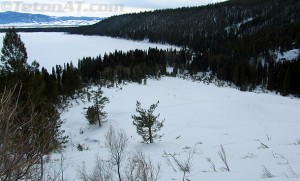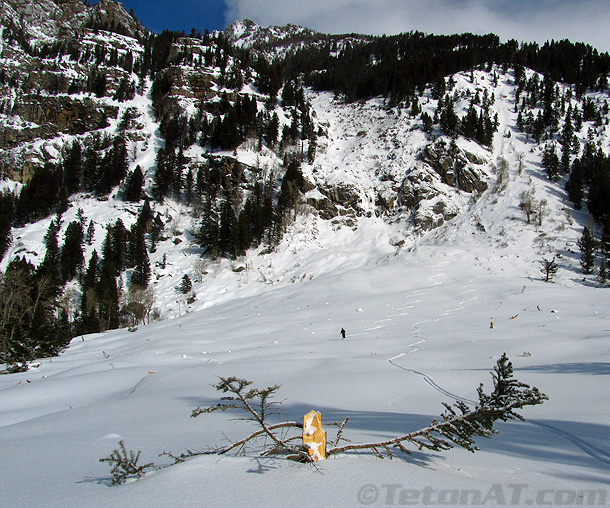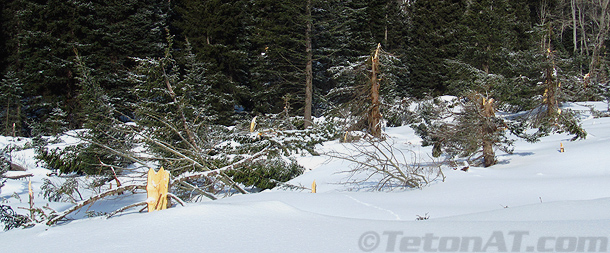So, last week I went on a ski tour to ski Son of Apocalypse Couloir on Prospector’s Mountain. Someone had skied it the day before (meaning we had sloppy seconds – something I hate), but they  dropped in not quite from the top, so my partner and I were still able to get some untracked turns in the upper section of the line. The skiing in the couloir was pretty good, with a few inches of snow on top of a solid base. The crux at the bottom was much more filled in since the last time I skied it and no air-time was needed to exit the couloir.
dropped in not quite from the top, so my partner and I were still able to get some untracked turns in the upper section of the line. The skiing in the couloir was pretty good, with a few inches of snow on top of a solid base. The crux at the bottom was much more filled in since the last time I skied it and no air-time was needed to exit the couloir.

Chris Onufer skis below the slide path.
On the skin in though, we passed by the base of Albright Peak and it’s southeast slope, which rarely gets skied due to avalanche danger. At first glance, I noticed that the area usually filled with moose brush (and moose) was coved in snow. I thought to myself, hmmm – is the snowpack so deep that all the brush and bushes are buried under the snow? With a closer look, I realized that yes, they were covered in snow, but from a massive avalanche that had come off the slope above. (I hope the moose didn’t get buried too!)

Tress broken 10′ above the snow.
As we got closer to the deposition area (now covered in fresh snow) it was obvious that a rather huge slide had occurred here. Large trees were knocked over and some were even broken off about 10 feet above the snowpack which I thought was rather odd. Did they break off from the wind blast in front of the avalanche, or from the slide debris itself? Either way, I thought that it was probably a D5 sized avalanche (or at least a D4…maybe a D5 goes all the way to Phelps Lake?) and about the maximum sized avalanche that the slope above could produce. No wonder it rarely gets skied!
US Avalanche Destruction Scale
D1 -Sluff or snow that slides less than 50m (150′) of slope distance.
D2 -Small, relative to path.
D3 -Medium, relative to path.
D4 -Large, relative to path.
D5 -Major or maximum, relative to path.
It’s pretty sobering to see massive trees broken like toothpicks from avalanche debris and it for sure makes you think twice about skiing lines with big run outs in questionable conditions. Even though I have always wanted to ski this southeast aspect of Albright, it will definitely take some more stable snow conditions to give me the green light.

i think maybe you mean R4 or R5 (size relative to path)??? D scale (from what I understand) is the destructive power, with D5 being major serac avalanches in the himalaya, etc… not trying to nit pick, just was a bit confused..
http://www.fsavalanche.org/NAC/techPages/articles/11_TAR_BirkelandGreene.pdf
hmmm…okay ianh…thanks. BUT…in the same article birkeland/greene describe one of the slides that destroyed large trees at the toe as R4D4…and it wasn’t even close to a major serac fall event.
after reading the article, as a american…maybe it would be a medium D5? or a R5D4? i’m no avy guru, so maybe one of our local experts familiar with the slide path can clarify.
Steve, in this case, you did indeed confuse the “R” and “D” descriptions with respect to avalanche size (relative to its path) and destructive potential. The two are related, but different.
The “RD” scale is not specific to North America (or the US), because it can describe both size and destructive potential anywhere given the local area/terrain.
ianh’s pointer to The Avalanche Review article is a good one and describes the two scales well, though the example noted therein may not be the best.
Hit up Comey or McCollister or any of the other fantastic local human resources at your disposal.
Have a look at Chapter 3 in the SWAG http://www.fsavalanche.org/Default.aspx?ContentId=45&LinkId=54&ParentLinkId=40
Just remember “R” for “R”elative to path and “D”for “D”estructive potential.
Or you could always use the less confusing but perhaps more descriptive Canadian Size Classification found here- http://www.avalanche.ca/cac/library/glossary/a-z?index=S
under “size”.
Take a Level 1. This is basic stuff.
Basic yes…but birkland’s example wasn’t perfect either…and he’s an avy pro. and to add…if there was a house at the bottom of this slide path, it would most likely have been destroyed. So I don’t think calling it a D5 is that far off.
And remember…it’s not the nomenclature that keeps you from getting buried.
A D5 avalanche is often described as “the largest snow avalanches known to man” and is typically a ~3000m path. I would go so far to argue as there aren’t any D5 avalanche paths anywhere outside of maybe Washington in the lower 48.Aa D4 avalanche could destroy a substantial portion of forest, or several buildings and typically runs around ~2000m. A D3 can bury and destroy a car or break a few trees and is usually around 1000m. D2 is what usually kills people (at least here in CO), and D1, barring a nasty terrain trap is pretty much harmless.
R scale on the otherhand simply describes what percentage of a slidepath slid and is relative to any given avalanche path
Regardless of how many D’s you give it , that slide is tiny compared to what I’ve seen in the Washington North Cascades. There is a slide path near Cascade Pass that ran from a hanging meadow into a mature Doug Fir forest, wiping out a quarter mile width of trees 3+ feet in diameter– not the little toothpicks we have here. I also recall a four day lock down at Snowbird back in the day which produced a 5′ fracture line on the back side that ran about 4,000 vertical into American Canyon. Not to say that the Albright wouldn’t ruin your day or produce instant deep frozen moose meat.
Regaurdless of how you classify the slide, Youre welcome for the sloppy seconds Steve ;p
the southeast side is really a quite pleasant ski run.
I got your D5 hangin bitches.
http://www.youtube.com/watch?v=3HxxzfUfFGk
This one was so big it has it’s own soundtrack. I know most everyone has seen it…but I’ll bet anyone sloppy seconds its a D5.
I applaud your restraint in not responding to Dave. “Take a Level 1. This is basic stuff.” Why is there always some guy who thinks it’s a competition?”
aaron…we did it top down, so it was a surprise to see your tracks.
Cool. Im not confident enough in judging conditions in a still unfamiar range but I think, as much as I enjoy a good climb, that top down it the best way to do it for sure.
Oh and we did ski it from the top but we went climbers right at the fork to where it cliffs out as opposed to left at the fork into the trees.